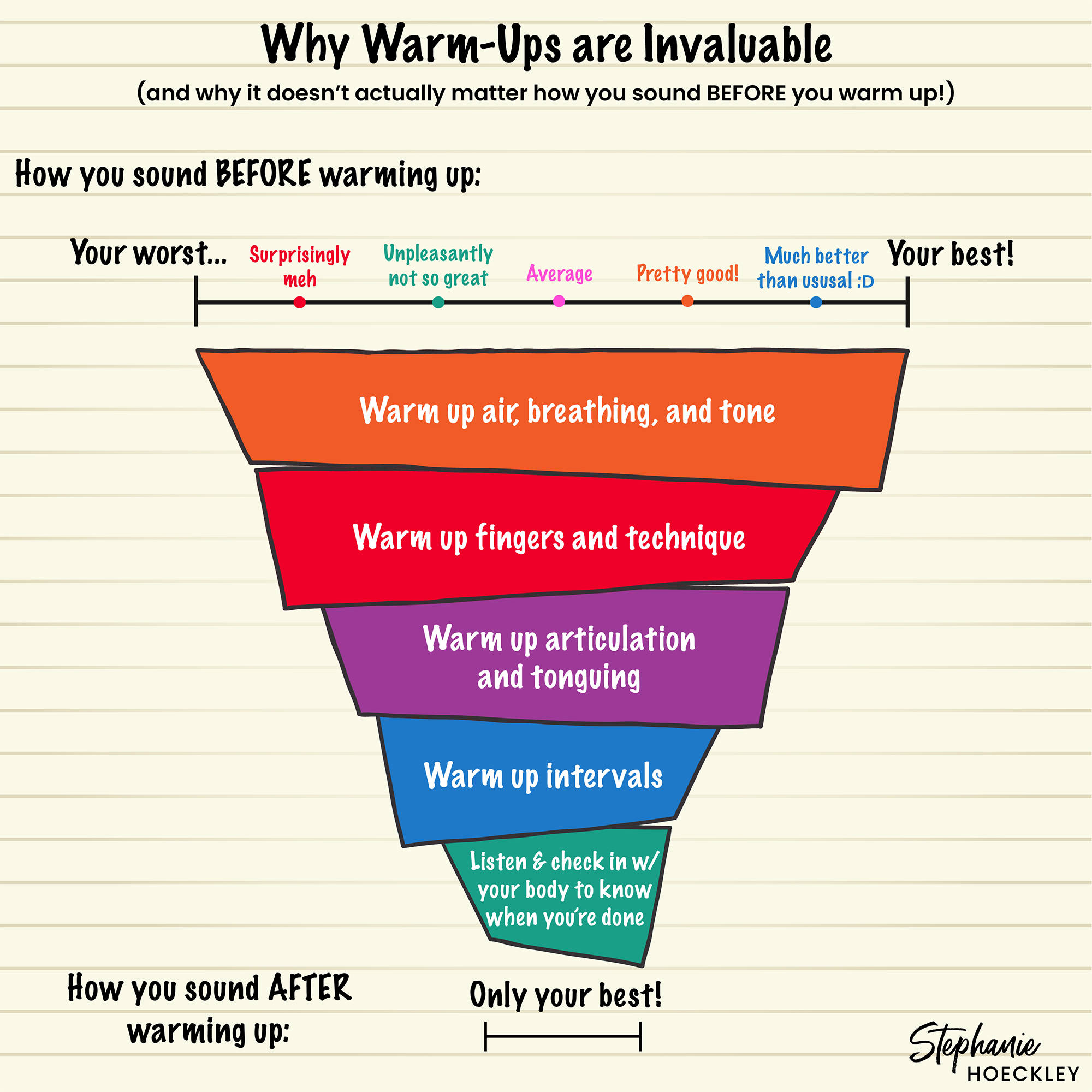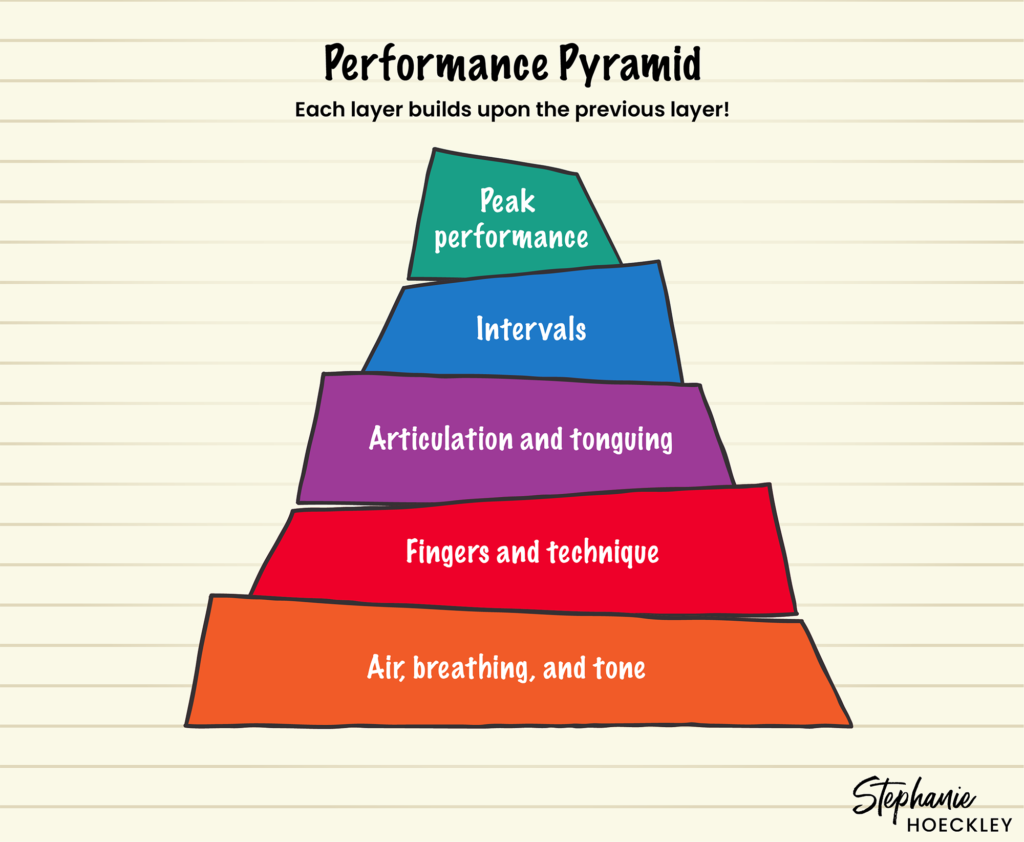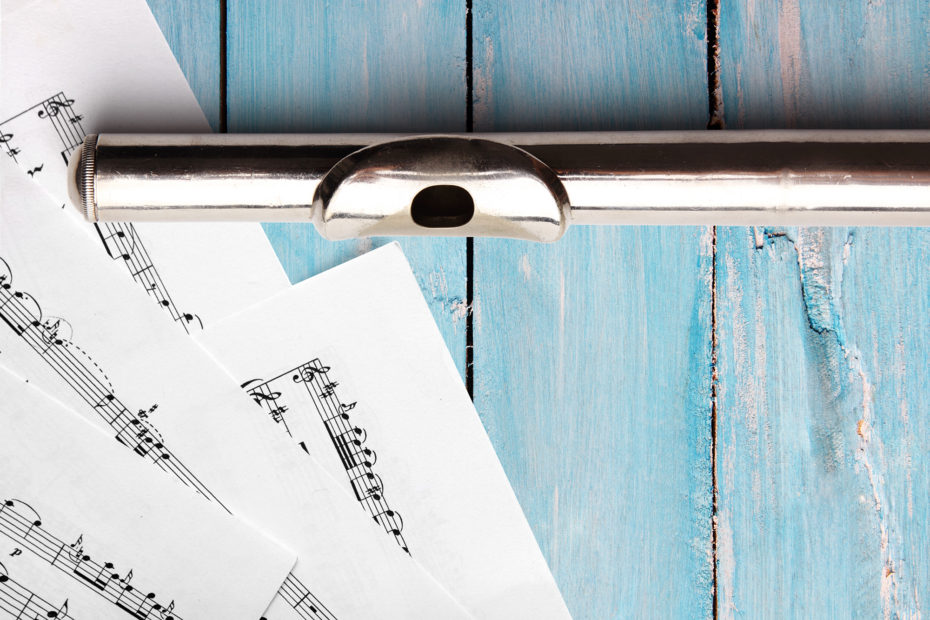I have a love/snooze relationship with flute warm-ups. I absolutely love them because they help me play my etudes and repertoire my very best, which is a beautiful gift to give yourself. From a perspective of experience and logic, they’re invaluable and never optional!
But emotionally, they can also be a total snoozefest when they feel redundant and inactive. However, warm-ups don’t have to be either of these things! Warm-ups should be active, flexible, and inspired! Your warm-up needs an overhaul if you’re experiencing any of these scenarios that myself and my students have tackled in our private flute lessons. Can you relate to any of these? (I know I can!)
- Your warm-up is the same every day and you’re dying to mix it up a little
- You go on auto-pilot and mentally check out while warming up to get to the fun stuff quicker
- You skip warming up entirely because you either aren’t sure what to play, how it will help, or you’re simply tired of it
Ouch! These realities don’t paint a very pretty picture, and if you’re experiencing these kinds of situations on a regular basis like so many musicians do, your practice sessions will be more difficult and uninspired from the get go (which makes it hard to even START practicing). But don’t worry, today I have some solutions so you can maximize your warm-up time without it zapping all your willpower before you even get to your repertoire.
Because like everything in music, the question is not IF you can make practice enjoyable, the question is HOW! Let me show you how to craft a killer warm-up that can adapt to your needs, mood, and energy level!
But before we dive into my favorite flute warm-ups and how you can craft yours on any wind instrument, I want to make sure you understand WHY warm-ups are so crucial! When we understand why and how things work in music, we make educated decisions and feel motivated to unlock the benefits we know are in the near future!
Why You Need to Warm Up
Every professional musician warms up before their practice and performances (when possible). But if you’re like me as a young fluteling, you’re probably wondering why exactly this is! Are warm-ups an ancient music tradition passed down from generation to generation? Does it deserve to have a place in modern music-making?
The answer is yes to both! Musicians have experienced the benefits of warming up for a very long time, but we also know more than ever about exactly why it is important.
Here are a few benefits of warming-up:
- It helps your finger, tongue, embouchure, and body muscles prepare for an ultra-precise, specialized workout
- It helps you settle your mind and focus effectively on your playing
- It helps prevent repetitive strain injuries
And perhaps my favorite:
- It takes however you sound today (good or bad) and helps you play at peak performance!
We’re not going to sound our best at the beginning of each practice session. It’s just not a realistic or plausible outcome (even for the pros)! So I want to take a moment to bust two BIG practice myths that I’ve seen countless musicians fall for (especially high school students and adults):
Practice Myth #1: If you don’t sound your best when you start practicing, you’re doing something wrong OR your focus/mindset/mood isn’t right.
Practice Myth #2: If you don’t sound good at the beginning of your practice, you won’t have a good practice session.
Both are FALSE.
We tend to think that we play our instruments with our mind, so if we don’t sound “right,” we think our mind or thoughts are the problem. 100% untrue. The reality is, our bodies play the flute, and our bodies are a little different every single day. If we sound different than we expect, we need to warm up and remind our muscles how they need to work to play our best.
There are all kinds of reasons why we sound different every day. Maybe we slept a bit funny last night and we’re feeling stiff, maybe we ate a lot of salt yesterday and our muscles are retaining more water today, and maybe we’re feeling anxious and we’re holding our muscles a little tighter than normal. There are lots of reasons, but as long as we have a complete warm-up that meets specific requirements, the outcome of our warmup will always be the same: We’ll play our best!

How to Know if Your Warm-Up is Actually Working
Useful warm-up routines need to check certain boxes. Once you know what these boxes are, there are all kinds of exercises you can use to create a comprehensive warm-up!
For wind musicians, there are 4 areas we want to warm up before we practice:
- Air, breathing, and tone (these are all linked!)
- Fingers and technique
- Articulation and tonguing
- Intervals
This is also a highly effective order to structure your warm up! Think about it, our air is the core of everything we do on our instruments. If we don’t warm up our breathing or our air usage, it will disrupt the evenness of our fingers, the clarity and speed of articulation, and the smoothness of our intervals. Without warming up your air, none of these things will work right, so start from the ground up! Your air is the base of the pyramid, and each category higher on the pyramid relies on a strong foundation of air.

Air, Breathing, and Tone Warm-Ups
Begin by warming up your air with breathing exercises; long tones; or simple, slurred passages to give your playing a strong foundation of air (flow, quantity, and speed), quality breathing, and a beautiful tone. This part of your warm-up should also include vibrato if your instrument uses vibrato! However, I recommend starting with a straight tone first so you can hear if your airstream is steady. (Vibrato can mask things like inconsistent airspeed, tone quality, intonation, and poor air control.)
Pro tip: Make sure you play EVERY note in your range, from your lowest note to your highest note. If you don’t, the notes you skip in the low and high registers will be the ones that get neglected and rusty over time.
Quick side note: The best way to improve notes in your range that are challenging is to play them daily. Which would you rather do? Stress about your high notes for years or play them a little bit every day so you can eventually play them well and never have to stress about them again? I know which long-term result I would choose, even if it feels a little uncomfortable now. Friends don’t let friends avoid the hard notes and then worry about them forever. Life is too short to let that stuff worry us instead of just chipping away at it daily until those notes are easy. 🙂
Plus, how else will you know if you sound fantastic on the notes you’re going to practice in your music today if you don’t play them all in your warm-up??
Depending on how easily your air is flowing, warming up your air may take more or less time than you expect. When I haven’t slept well or I’m playing early in the morning, it takes me extra time to get my air to where it needs to be. Physically, my muscles are still a bit sleepy! But any less-than-ideal starting point doesn’t worry me anymore because I trust my warmup will get me across the finish line. You can, too!
How do you know when to move on from air to fingers and technique?
I use my ear and body awareness as diagnostic tools. I ask myself, “Is my air FEELING free and easy yet?” and I answer myself honestly. If I feel like I’m working too hard to move my air, I’m relying too much on my embouchure, or I’m tensing up my throat or body, I’m not quite done yet.
Once your air is flowing, your body is feeling comfortable with the notes in your range, and your ear is telling you your sound is rich and focused, it’s time to move on to your fingers!
Finger and Technique Warm-Ups
Remember how I said warming up is like a pyramid? Here’s where this analogy really helps. When you’re warming up your fingers, your fingers aren’t working in a vacuum. You aren’t really only warming up your fingers in this section. You’re warming up your fingers while continuing with your best sound and proper air usage.
Make sure that any quick or tricky technique exercises aren’t sacrificing your tone quality or air usage or you’re not going to be able to play these technical exercises in your repertoire with a lovely sound. In other words, don’t let your air know what your fingers are doing!
What can you use to warm up your fingers? Slur anything that appears frequently in your etudes, ensemble music, or solos! Music is made up of scales, arpeggios, triads and seventh chords, and intervals, so infuse your fingers with practical theory knowledge with common musical elements like chromatic scales, major/minor scales, scale patterns, thirds, and triads (major/minor/diminished/augmented). You can also go further and dive into seventh chords, more intervals (minor thirds, fourths, fifths, etc.), whole tone scales, octatonic scales, and broken arpeggios (when the chords are not in root position [inversions]).
There are a lot of options for technique practice, so be strategic about what you tackle by asking yourself two questions:
1) Which exercises will be useful today?
And also think ahead:
2) Which exercises will help me improve my weak areas?
Choose exercises that answer both of these questions.
The benefits of #1 are pretty obvious! You warm up what you have to do today in your etudes, solos, ensemble music, etc. But let’s expand a bit on #2. If we only ever practice and warm-up with question #1, the music we are currently playing determines the areas of our playing that are strong and frequently covered. This can mean that certain areas get perpetually neglected. It might be a note or two, or it could be a HUGE area like not playing the sharp scales. This may or may not be a problem today, but it WILL affect our flexibility in the short-term and our abilities and skill in the long-run.
For example, if we encounter different kinds of technical passages in sightreading, receive new ensemble music, or are suddenly offered a substitute position in an orchestra or chamber ensemble, we want our fingers to be prepared!
We can’t limit our technique warm-up to only what we plan to practice today, so make sure you address any weak areas and regularly rotate through different techniques so your fingers are fresh and always have the latest software update!
Just like when you’re warming up your air and sound, you know you’re done when you’ve 1) covered all your bases and 2) your fingers are moving quickly, evenly, and easily! Use your ear and check in with your body to know when you’re ready to move on.
Articulation and Tonguing Warm-Ups
Once your air and fingers are warmed up, it’s time to warm up the strongest muscle on your body for its size: the tongue! Articulation can be sluggish before we warm up, and articulation may not line up with the fingers.
My favorite way to warm up articulation is by alternating slow and fast articulated notes. For example, I like taking my favorite scale passage and playing it with the rhythm: 8th – 16th – 16th so my tongue is moving quickly for the 16ths but rests a bit on the 8th-notes. Another example is a quarter note and then 4 16th-notes. Giving my tongue time to rest in-between faster articulations feels like a gentle way to wake up my articulation. It also helps me avoid tensing up my tongue by throwing it into the deep end of the pool with straight 16th notes!
Pro tip: When warming up articulation, start with a long note and then short notes. It’ll help you move your air for the long note, which will continue through your shorter articulated notes. The air needs to move, always!
What can you use to warm-up your articulation? You can ask yourself, “What didn’t I cover in my technique warm-up?” Because we’re building on top of air and technique, you can get more bang for your buck if you combine articulation with technique practice like scale passages! As your articulation becomes quicker and cleaner through your warm-up, you can increase your tempo and eventually tongue faster rhythms like straight 16th notes.
Don’t forget about the pyramid, though: Make sure you use plenty of air and clean technique while warming up your articulation! Even the cleanest articulation with an undesirable sound will be unpleasant to listen to in our repertoire, so we don’t want to reinforce this in our warm-ups.
Interval Warm-Ups
The last area you want to warm up is intervals, which involves slurring notes to control your embouchure and air speed. Depending on your instrument, you may warm up your embouchure more or less than other instruments. For example, intervals are crucial for brass player’s embouchures. On flute, they’re more important for not overusing our embouchure and creating a flexible air speed instead.
Which intervals are helpful? Octaves are invaluable because they are sprinkled all over our music! But in truth, anything wider than a third or a fourth can help you warm up your embouchure muscles and your air speed. Even full-range arpeggios up and down will fit the bill! (Just like in the technique section, broken arpeggios can be helpful here, too.) Exercise your full range with wide intervals until 1) Each note speaks cleanly right away (smooth connections between the notes), and 2) Your tone quality and intonation are spot-on.
And that’s it! Once you’ve hit these 4 areas and built your pyramid, you can trust that you’ve set yourself up to play your music your very best!
Help! My Warm-Up Routine is Too Repetitive and I’m Uninspired…
The beauty and inspiration of warming up comes from having different exercises on hand or in a rotation so everything feels fresh. Knowing the boxes to check and having a few exercises meet the requirements means your warm-up can vary slightly every day (hello variety)! They can also be tailored to be longer or shorter depending on the time you have available (for flexibility in your schedule). And most of all, they can ensure you’re sounding fabulous by the end!
We’re aiming for the perfect balance of routine and novelty! Here’s why this combo works. If you don’t have a set routine or core exercises you can rely on, you’re going to be making a lot of decisions at the beginning of your practice. Each decision takes time and energy, and can also lead to decision fatigue!
It doesn’t make sense to spend all your decision energy before you get to the meat of your practice (just like in sports, it doesn’t make sense to tire yourself out with your warm-up before you start the match)!
On the flip side, having one set routine that you use every day can get dull quicker than Emmanual Pahud plays Voliere from Carnival of the Animals! Although a set daily routine may work for some, many of us need some variety to stay inspired and present in the moment. All you have to do is pick exercises that check the boxes, and they can vary depending on what you need and what you feel like playing!
Practice Energy Hack!
Before we get into the specific exercises I use on the flute, here’s one last tip that has helped me START practicing when I don’t feel like it more times than I can count. It’s simple and one of my favorite energy hacks!
If you have a lot of energy and don’t feel like you can focus: Warm up while walking around!
When I have a lot of energy or I’m feeling a bit anxious, the idea of sitting down for a detailed and diligent practice session can feel impossible! Walking around as you play will help you gently harness your focus, get out of your head and into your body, and you won’t feel trapped to one spot or tied to a chair.
If you are wiped out and are low on energy: Start warming up while sitting down.
Generally we’ll discover more energy as we play, so you can stand up when you’re ready! A cold glass of water and a good stretch goes a long way, too.
My Flute Warm-Up Routine
Here are my favorite exercises for warming up these 4 areas on the flute! I have a variety of exercises for each category so I can pick and choose what speaks to me today, feels most useful, or will help me address my weaknesses. I generally pick a few in each category if I have the time. Here are the core exercises I use the most frequently! Enjoy!
Tone:
- Breathing exercises
- Long tones
- Start in the middle register and work down to the low register, then restart in the middle register and move upwards!
- Starting in the low register can lead to an aperture that is too loose and open
- Starting in the upper register can cause us to pinch our aperture and overuse our lips
- Start in the middle register and work down to the low register, then restart in the middle register and move upwards!
- De La Sonorite, especially #1
- Trevor Wye Tone Book
- Slow and slurred 2-octave chromatic scales (full-range)
- I start on low B and play up and down 2 octaves, then C, C#, etc.
- Extended techniques: Whistle tones and singing while playing
Technique:
- 17 Daily Exercises (17 Grands exercices journaliers de mécanisme) – Taffanel and Gaubert
- 1, 2, 4, and 17
- 28-Day Warm-Up Book – Paul Edmund Davies (advanced)
- Daily Exercises – Marcel Moyse
- A, B, C, D, and E
- 7 Daily Exercises – Reichert
- 1, 2, and 4 are my favorites
Articulation:
- 7 Daily Exercises – Reichert
- 6 and 7
- 17 Daily Exercises – Taffanel and Gaubert
- AKA 17 Grands exercices journaliers de mécanisme, also known as EJ)
- EJ 1, 2, 4, and 17
Intervals:
- Harmonics (First 4 notes in the overtone series, especially)
- 7 Daily Exercises – Reichert
- 3 and 5
- 17 Daily Exercises – Taffanel and Gaubert
- 10 is invaluable! As are the broken arpeggio versions afterward.
- 28-Day Warm-Up Book – Paul Edmund Davies (advanced)

About the Author | Dr. Stephanie Hoeckley, Flutist, Educator, & Gamification Guru
Hi! It’s so nice to meet you! Thanks for stopping by my blog! My name is Dr. Stephanie Hoeckley, and I’m a professional flutist and music educator in Phoenix, AZ. I use gamification to help musicians and educators like you hack your motivation, organize your time, and level up your performance skills so you can create the musical reality of your dreams! And I help music educators activate this same superpower for their students, too.
If you enjoyed this post, be sure to check out the digital resources I’ve created for musicians like you or sign up for private flute lessons!
Have fun and game on,

